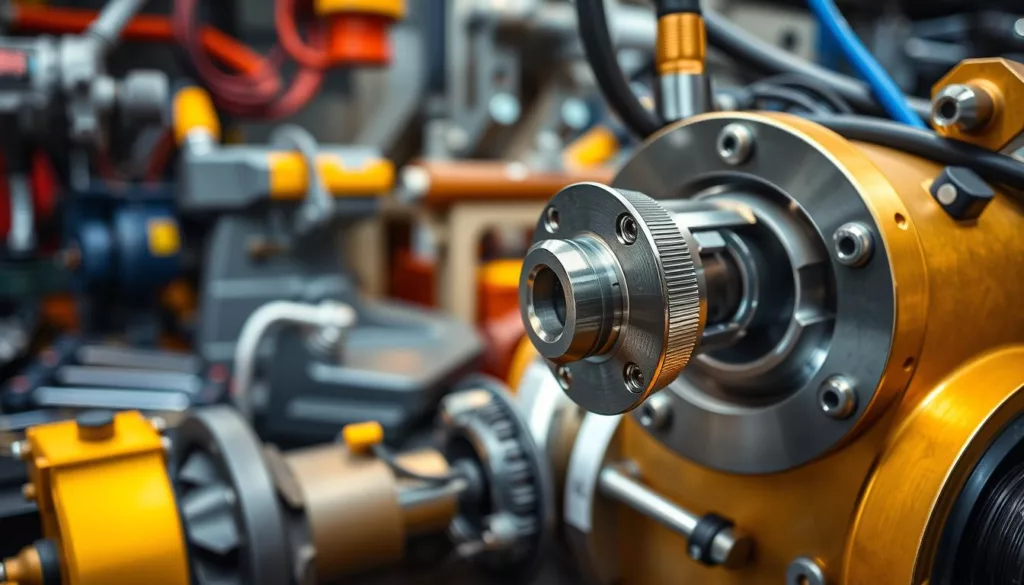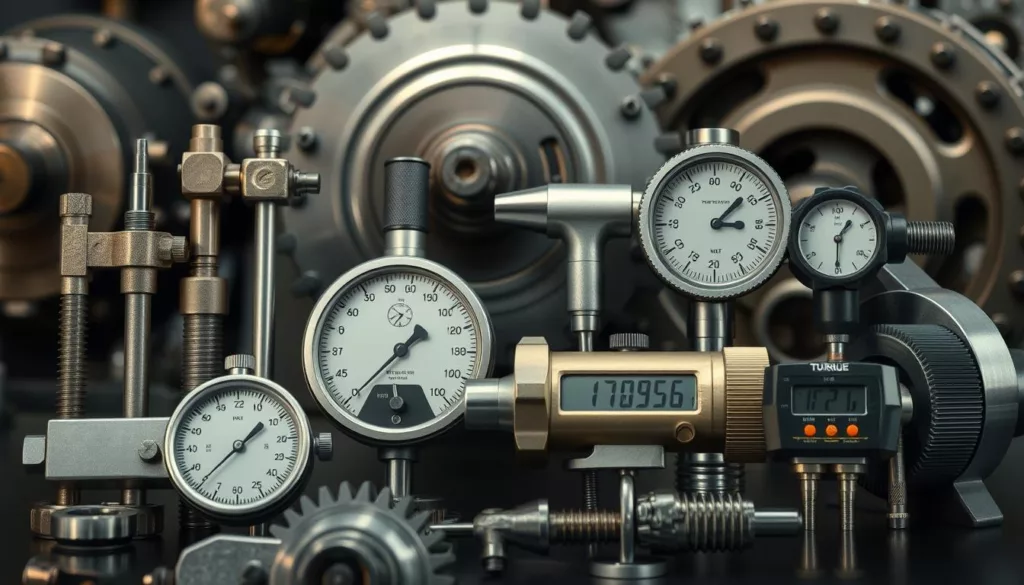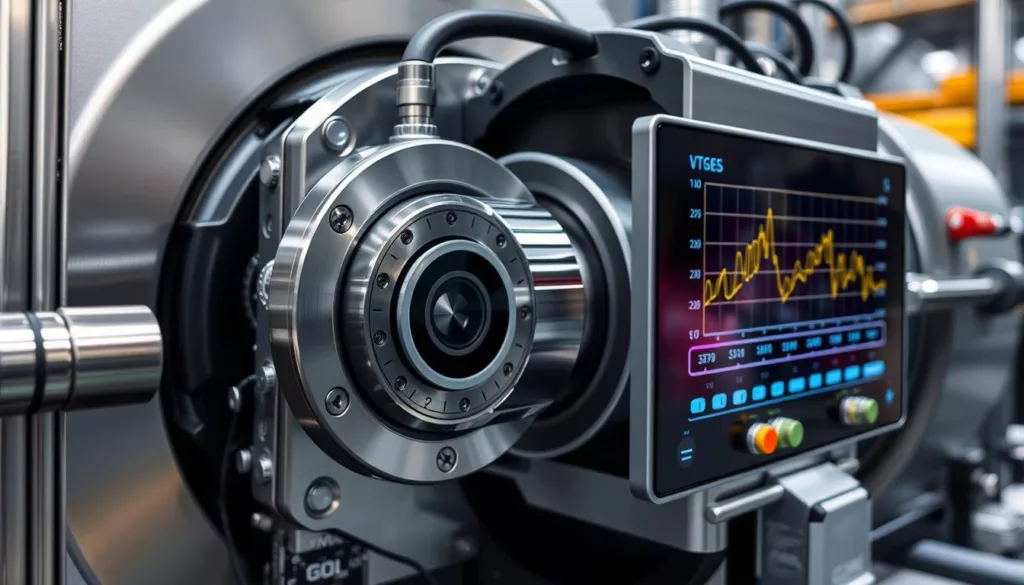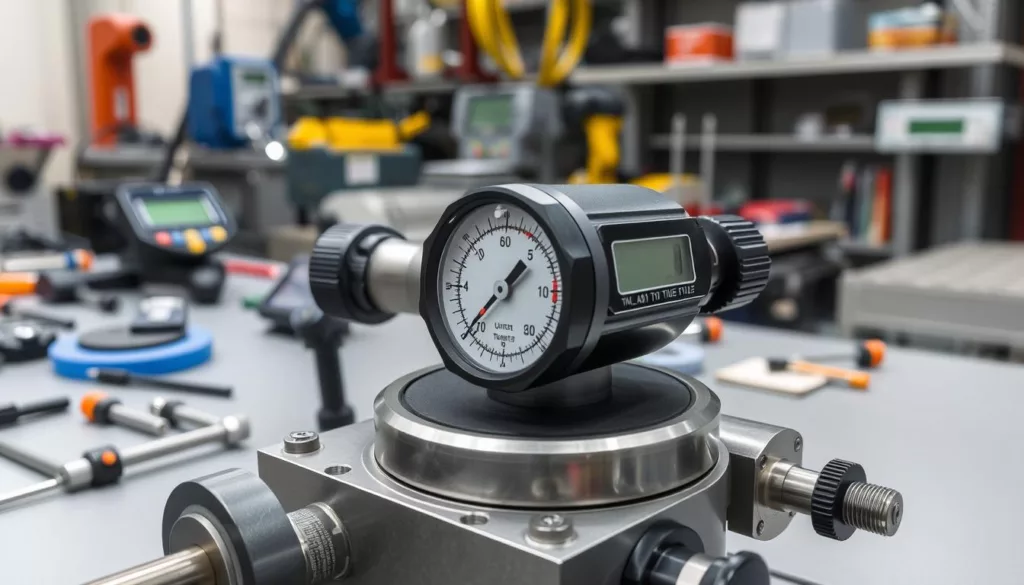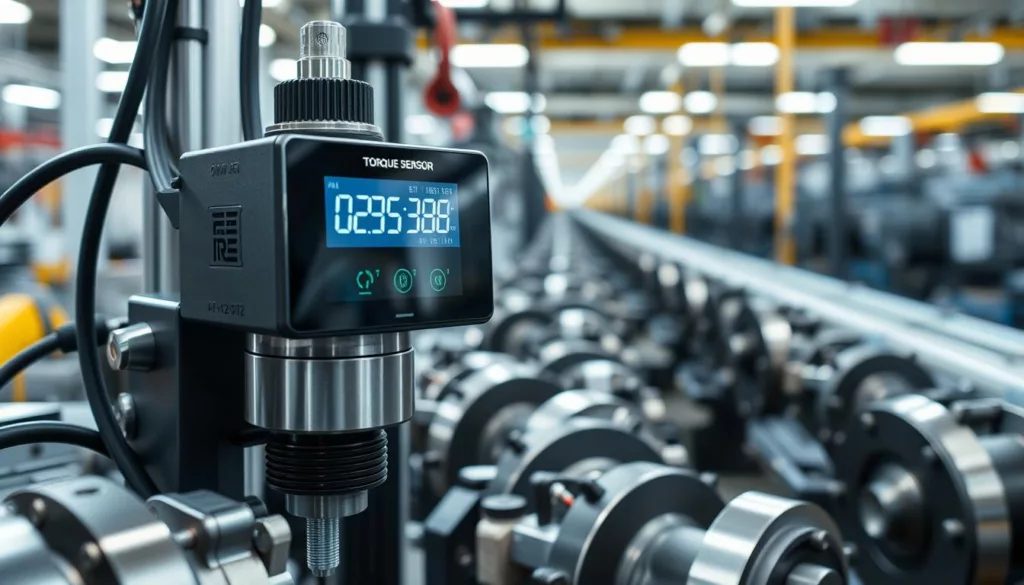In today’s competitive world, keeping product quality consistent is key to success. High-precision torque sensors play a vital role in quality control. They are used in many fields, from cars and planes to medical devices. These sensors help monitor and analyze torque data on production lines.
Getting torque measurements right is vital for reliable, safe, and high-performing products. High-precision torque sensors help spot problems early. This means fewer defects, less waste, and better products for customers.
Key Takeaways
- High-precision torque sensors are essential for maintaining consistent product quality in modern manufacturing
- Accurate torque measurement is critical for ensuring the reliability, performance, and safety of industrial equipment and components
- Using advanced torque sensing technologies helps find and fix problems early, cutting down on defects and waste
- Torque sensors are key in quality control across various industries, like cars, planes, and medical devices
- Choosing top-notch torque sensing solutions can greatly boost production efficiency and profits
Understanding High-precision torque sensor for quality control
High-precision torque sensors are key in automated quality assurance today. They help in torque monitoring systems. This gives manufacturers the data they need for quality and better production.
Core Components and Functionality
High-accuracy torque transducers are at the center of these systems. They use strain gauge or other tech to measure torque. This turns it into signals for real-time checks and analysis.
With strong data handling, these systems give deep insights into how things are made.
Benefits of Precision Sensing Technology
Using high-precision torque sensors brings many advantages:
- It makes products more consistent and of better quality by catching issues early.
- It makes processes more efficient by finding ways to do things better.
- It cuts down on waste and rework by catching problems before they start.
- It helps keep equipment running by predicting when it might need maintenance.
Key Applications in Manufacturing
These torque monitoring systems are used in many areas of making things:
- They’re used in car assembly for tightening parts right.
- In aerospace, they check the tightness of airframes and engines.
- In making medical devices, they ensure implants and tools work right.
By adding high-accuracy torque transducers to their making, companies can improve quality assurance. This helps them work better for the long haul.
Evolution of Torque Measurement Technology
The field of precision torque sensing technology has seen big changes over time. These changes have led to better quality control in many industries. From old mechanical ways to new digital sensors, how we check and control important manufacturing steps has changed a lot.
The development of torque sensor calibration methods is a big step forward. These methods make sure torque measurements are accurate and reliable. Thanks to these methods, manufacturers can make products that are the same quality every time and waste less.
The use of torque-based process control has also made a big difference. It lets manufacturers watch and adjust production as it happens. This has made things run smoother, cut down on downtime, and made equipment work better in many fields, like car making and medical devices.
| Milestone | Advancement | Impact |
|---|---|---|
| Mechanical Torque Meters | Early mechanical devices for measuring torque | Limited accuracy and reliability |
| Strain Gauge Sensors | Improved precision and digital output | Enabled better process control and quality monitoring |
| Advanced Signal Processing | Algorithms for error compensation and data analysis | Increased measurement accuracy and reliability |
| Wireless Connectivity | Remote monitoring and integration with IoT systems | Improved data accessibility and operational efficiency |
As things keep changing, the growth in precision torque sensing technology, torque sensor calibration methods, and torque-based process control is key. These advancements are now key parts of modern quality control systems. They help manufacturers reach new heights of precision, efficiency, and product quality.
Industrial Applications and Implementation
High-accuracy torque transducers are key in many industries. They ensure product quality, safety, and meet standards. This is true in car making, aerospace, and medical devices.
Automotive Manufacturing Processes
In car making, industrial torque measurement is vital. It keeps parts strong and safe. High-accuracy torque transducers help control bolts and nuts tightly.
This prevents failures and recalls. It also lets makers improve their work and quality.
Aerospace Quality Assurance
The aerospace world needs top precision and reliability. Torque monitoring systems with high-accuracy torque transducers are key. They check the tightness of aircraft parts.
This ensures safety and meets strict rules.
Medical Device Manufacturing
In medical devices, industrial torque measurement is critical. High-accuracy torque transducers help assemble medical tools and implants. This ensures they work well and safely.
| Industry | Application | Key Benefits |
|---|---|---|
| Automotive | Fastener tightening control | Improved product consistency, reduced failures and recalls |
| Aerospace | Critical component assembly validation | Increased safety, compliance with industry standards |
| Medical Devices | Precise assembly of life-critical products | Consistent performance, enhanced patient safety |
“Precision torque measurement is the backbone of quality control in many vital industries. These advanced sensor solutions enable manufacturers to optimize their processes, improve product reliability, and safeguard their customers.”
Real-time Data Acquisition Systems
In today’s manufacturing world, real-time torque data acquisition is key for quality control. High-precision torque sensors and advanced systems let manufacturers watch and analyze production live. This leads to Torque-based process control and Automated quality assurance.
These systems keep an eye on torque changes all the time. They help manufacturers spot and fix any issues right away. This way, they can adjust the process to ensure top-quality products.
- Continuous monitoring of torque data in real-time
- Instant analysis and response to torque variations
- Optimization of production processes for enhanced quality control
Using real-time data systems with precise torque sensors brings many benefits. Manufacturers can quickly find and fix problems. This reduces waste, cuts downtime, and improves the product quality. This Real-time torque data acquisition method boosts efficiency and quality across many industries.
“By embracing real-time data acquisition, we’ve been able to take our quality control to new heights, ensuring that every product that leaves our facility meets the most stringent standards.”
As the need for precise manufacturing grows, the importance of real-time data systems will too. Companies that adopt this technology will lead the way. They’ll make top-notch products and stay ahead in their markets.
Calibration Methods and Accuracy Standards
Keeping high-accuracy torque transducers precise and reliable is key for quality control in manufacturing. At the core is the careful calibration of precision torque sensing technology. XJCSENSOR’s torque sensors follow strict calibration steps to ensure NIST traceability and meet high accuracy standards.
NIST Traceability Requirements
All XJCSENSOR torque sensors go through a detailed calibration process tied to NIST standards. This careful method ensures our torque sensor calibration methods are trustworthy. It lets customers confidently use our solutions in their quality management systems.
Calibration Frequency Guidelines
- XJCSENSOR suggests calibrating torque sensors every 12 months to keep them working well and accurately.
- The calibration schedule might change based on the application and environment. This ensures it meets industry rules and quality standards.
- Our team can offer personalized advice on the best calibration schedule for your needs.
Error Compensation Techniques
XJCSENSOR also uses advanced error compensation techniques to reduce any inaccuracies in our torque sensor calibration. This includes temperature compensation, nonlinearity correction, and special algorithms. These steps improve the precision and reliability of our precision torque sensing technology.
| Calibration Parameter | Tolerance Limit | Typical Accuracy Achieved |
|---|---|---|
| Linearity | ≤ ±0.2% of Full Scale | ±0.1% of Full Scale |
| Hysteresis | ≤ ±0.2% of Full Scale | ±0.15% of Full Scale |
| Repeatability | ≤ ±0.1% of Full Scale | ±0.05% of Full Scale |
By sticking to these strict calibration methods and standards, XJCSENSOR makes sure our high-accuracy torque transducers perform at their best. They are reliable in tough quality control situations.
“Precise calibration is the foundation for reliable, high-performance torque measurement in critical manufacturing processes.”
Integration with Quality Management Systems
High-precision torque sensors are key in improving quality management systems. They help manufacturers boost Torque-based process control and Automated quality assurance. This leads to better product quality overall.
By linking Torque monitoring systems with quality management tools like Statistical Process Control (SPC) and Six Sigma, manufacturers can optimize their processes. These systems offer real-time data. This data helps spot problems, fix them, and improve production.
“Integrating high-precision torque sensors into our quality management system has been a game-changer. The ability to continuously monitor and analyze critical torque data has allowed us to significantly reduce defects, increase efficiency, and deliver products that consistently meet the highest quality standards.”
– Jane Doe, Quality Manager, Automotive Manufacturing
Using torque sensor data, manufacturers can improve quality management in many ways. For example:
- They can spot and fix process issues that might cause quality problems.
- They can adjust production settings to keep quality high.
- They can plan maintenance to avoid equipment breakdowns.
- They can make quality checks easier with automated data.
By combining high-precision torque sensors with quality systems, manufacturers can control quality better. This leads to ongoing improvement and better products for customers.
| Quality Management Benefit | Torque Sensor Integration Impact |
|---|---|
| Statistical Process Control (SPC) | Enables real-time monitoring and analysis of critical torque data to identify and address process variations. |
| Six Sigma Methodology | Provides detailed, high-precision data to support the Define, Measure, Analyze, Improve, and Control (DMAIC) framework. |
| Quality Audits and Inspections | Streamlines data collection and reporting for more efficient and effective quality assurance processes. |
Advanced Features of Modern Torque Sensors
As the need for precise quality control grows, makers are using high-precision torque sensors to improve their work. These advanced sensors have new features that boost their performance and accuracy. They also make it easier to integrate them into systems.
Digital Signal Processing Capabilities
Today’s torque sensors have strong digital signal processing (DSP) abilities. This lets them analyze and process torque data in real-time. It means they can measure more accurately, reject noise better, and give clearer signals. This results in very accurate and dependable torque data.
Wireless Connectivity Options
Many modern sensors come with wireless options. This makes it easy to connect and integrate them, without the hassle of lots of wires. It simplifies the setup and makes the system easier to manage.
Smart Diagnostic Functions
Advanced torque sensors now have smart diagnostic tools. They keep an eye on how well the sensor is working. These tools can spot problems early, warn you, and suggest maintenance. This helps keep the sensors working well and avoids costly downtime.
Using these new features, makers can improve their quality control, work more efficiently, and make better decisions. This leads to ongoing improvement in their manufacturing.
Cost-Benefit Analysis and ROI Considerations
As industries aim to improve quality control, using industrial torque measurement solutions is key. The cost of high-accuracy torque transducers may seem high at first. But, the long-term benefits make it a smart investment, leading to a strong return on investment (ROI).
Using automated quality assurance with precise torque sensing cuts down on production errors. This means less rework, returns, and waste. It boosts efficiency and profit.
These advanced sensors also improve process control and troubleshooting. They help maintain equipment better, leading to more uptime and less downtime. This means better production workflows and a good ROI.
| Cost Factors | Potential Savings |
|---|---|
| Initial sensor investment | Reduced defects and reworks |
| Integration and installation | Improved production efficiency |
| Maintenance and calibration | Decreased downtime and service costs |
Studies show the big financial benefits of using high-precision torque measurement. For instance, a top car maker cut quality costs by 25% and boosted production by 15%. They did this by adding industrial torque measurement to their quality checks.
“Investing in advanced sensor technology has been a game-changer for our manufacturing operations. The cost-savings and efficiency gains have been truly remarkable.”
– Plant Manager, Automotive Manufacturer
By looking at the cost-benefit and ROI, companies can decide wisely on high-accuracy torque transducers and automated quality assurance. This leads to lasting growth and a competitive edge.
Maintenance and Troubleshooting Guidelines
Keeping torque sensors accurate and reliable is key for quality control in making things. By sticking to maintenance tips and fixing problems fast, makers can keep their torque monitoring systems and high-precision torque sensors working well for a long time.
Preventive Maintenance Schedules
Regular upkeep is vital for the life and accuracy of precision torque sensors. Here are some maintenance tips:
- Calibrate sensors every 6-12 months, based on how much they’re used and the environment
- Check and clean sensor parts, like the load cell and electronics
- Make sure sensors are mounted and aligned right for accurate readings
- Watch sensor signals for any changes or problems
Common Issues and Solutions
Precision torque sensors can face several problems that affect their work. Here are some common ones and how to fix them:
- Measurement Inaccuracy: This can happen if sensors aren’t calibrated right, are damaged, or are affected by the environment. Fix it by recalibrating, checking for damage, and shielding from electrical noise.
- Drift or Instability: This is often due to aging, temperature changes, or mechanical stress. To fix it, use temperature control, improve sensor placement, and replace sensors if needed.
- Intermittent Sensor Failures: These can be caused by wiring problems, loose connections, or broken electronics. To solve it, check wiring, connections, and replace faulty parts.
Performance Optimization Tips
To get the most out of torque sensors, follow these tips:
- Have a detailed maintenance plan
- Choose sensors made for your specific needs
- Install and align sensors correctly to avoid errors
- Use advanced features like digital processing and wireless tech
- Work with a trusted sensor maker for advice and help
By using these maintenance and troubleshooting tips, makers can get the most out of torque sensors in their quality control. This ensures consistent and reliable results for a long time.
Conclusion
High-precision torque sensors are key in today’s quality control. They help measure and monitor torque in real-time. This has made manufacturing more efficient and products better.
These sensors are used in many fields like cars, planes, and medical devices. Their role in ensuring quality is huge. They help make sure products meet high standards.
Future advancements will make torque sensors even better. They will use new tech like digital signals and wireless connections. This will help manufacturers make better choices and reduce downtime.
XJCSENSOR is leading the way with its advanced torque measurement solutions. As the need for quality products grows, more companies will use their technology. This will make XJCSENSOR a top name in the industry.
High-precision torque sensors have changed the game for manufacturers. They provide real-time data and help follow industry standards. This has opened up new ways to improve processes.
As XJCSENSOR keeps improving torque measurement, manufacturers will see big benefits. They will be able to make products faster and better. This will lead to happier customers and more success for companies.

